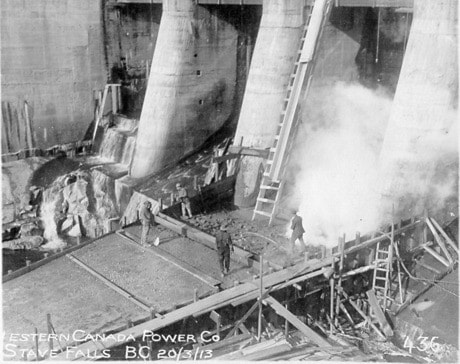Given all the fuss over B.C. Hydro’s new smart meters and whether or not they’re required, safe, or a major invasion of privacy, it is interesting to look back at a time when what people knew about electrical power was that they wanted it – and the sooner the better.
This year’s Canadian Heritage theme is “The Heritage of Power,” so all across the country, Canadians will be learning more about how we have kept the lights on over the past 100 years.
In the early days of exploration on the Stave River, two resources stood out – the massive trees and the equally massive potential for the production of hydroelectric power.
Development of a generator that could work with hydraulic power sources occurred in the 1870s.
The first generating plant was built in Britain in 1878 with others soon to follow in the U.S. and Canada.
So from the earliest days of settlement, the lower Stave attracted attention from anyone with an engineering background.
It wasn’t until 1909 that the means to get the necessary supplies to the dam site was developed by the Western Canada Power Company. It constructed the world’s shortest chartered railway to take men and materials from Ruskin to the site of the first dam on the outlet of Stave Lake.
The dam and powerhouse were completed in early 1912 and began producing power for the Lower Mainland.
Electrical power came to community centres along the railway line fairly quickly.
According to the Fraser Valley Record, power company representatives were making presentations to municipal councils regarding transmission lines and access to power as early as 1910.
Haney and Hammond had service by late 1912.
For the Western Canada Power Company, access to power was the carrot used to arrange grants for transmission line construction along railway lines and the Dewdney Trunk. The main aim was to get power to the larger and more quickly growing Lower Mainland communities.
Like any other modern community service, the development of infrastructure for delivery of electrical power was a long, slow process. Even those households located on the Dewdney Trunk and River Road distribution lines would have had to pay for the line to their house in addition to a monthly bill.
For those in the agricultural areas, where houses on large farms were some distance apart and at the end of a long driveway, even service to their road was a long time coming.
What was quicker to come were the electrical appliances with their promises of speed and convenience.
But the greater appeal and more immediate need was for electric light.
While there remained parts of the rural Fraser Valley that did not have electricity until the 1960s, there was an interim solution for those determined to have light. Large glass batteries – the size of our modern car batteries – were lined up in a row in a lead-lined box attached to the house. Seeing one today, we would likely mistake it for a flower box.
The home-owners would charge the batteries by attaching them to their automobile in a long, tedious and gas-guzzling process. A wire and cap extending out from the house – usually on a kitchen wall – would be attached to the first battery in line. Inside, this wire would lead to an outlet that supported one electric light bulb and one other outlet that could be used for a radio or other appliance.
As the battery ran down, someone would run outside and move the connector caps down the line until the whole re-charging process needed to be done again.
If you’re keen to know more about how our hydroelectric power was developed, join us at the annual Heritage Tea at the Senior’s Centre on April 14, when a display on our hydroelectric riches will be one among many.
Val Patenaude is director of the Maple Ridge Museum.
